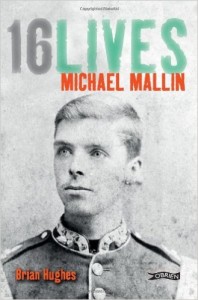16 Lives: Michael Mallin, Brian Hughes
The O’Brien Press, Dublin 2012
ISBN: 978-1-84717-266-2
Paperback, with illustrations in black and white, timeline, map of Dublin, appendices, notes, bibliography and index
256 pages
€14,99
From British imperialist soldier to socialist revolutionary
Michael Mallin is one of the lesser known of the leaders executed in the aftermath of the 1916 Easter Rising. Being the first full-scale biography ever written of Mallin, this book contains many previously unexplored aspects of his life. The author, Brian Hughes, studied history at the National University of Ireland in Maynooth and at Trinity College, Dublin.
Born in 1874 as the son of a skilled craftsman, Mallin grew up in a tenement building in Dublin. His mother came from a British army family but nevertheless was very angry with young Mallin when he decided to become a drummer boy in that army at age fourteen, in 1889. He signed up for twelve years service and after some years in Ireland and Britain was to see active duty in India. It was here that he grew to hate the British army for its imperialistic goals and its fight against the native Indian population that was struggling for freedom. With the help of letters Mallin wrote to his fiancee Agnes Hickey, Hughes shows how Mallin’s political views radicalized during his time in India because of the unjustice he witnessed day by day. His fiancee Agnes too held strong nationalist views by that time already, which makes it possible she also may have influenced Mallin through the letters she sent him.
After returning from service Mallin soon began working as a silk weaver, around 1903, and was already secretary of the silk weaver’s union in 1908, which signifies his strong feeling for social justice. In the meantime he got married with Agnes Hickey and became father of the first of his eventual five children. In the beginning of 1913 Mallin was well underway becoming a prominent trade union leader and got involved in the silk weaver’s strike at Messrs Atkinson’s and Co. Unexpectedly this strike ran for months, where the union had expected a swift victory. Despite dragging on until August when also the Great Dublin Lockout started, the silk weaver’s strike ended in success for the workers. Soon after the eventually successful strike at Atkinson’s, Mallin left the company and tried to set up some unsuccessful businesses, such as a chicken farm outside Dublin and a city cinema. It remains unclear if Mallin chose to leave Atkinson’s voluntarily, and if so, why he chose to do so. Both new ventures were soon abandoned and Mallin probably resumed working as a silk weaver from his Dublin home. Sources are scarce fort his period of Mallin’s life. In 1914 however, he became involved in the Irish Transport and General Workers Union (ITGWU) and soon led the Inchicore branch of the union.
When in 1913 James Connolly, Jack White and ‘Big Jim’ Larkin came up with the idea of the Irish Citizen Army (ICA) to protect striking and protesting workers from government violence, Mallin was not yet involved. Later, when Jack White got disillusioned with the small number of recruits and their quickly fading enthusiasm, Mallin took over the training and drilling of the ICA. With thirteen years experience in the British army, Connolly saw in Mallin the perfect man for this job. Although Mallin was to be second-in-command of the ICA during Easter Week, he and Connolly don’t seem to have been very close. Their relationship was one of mutual respect, not intimate friendship per se.
Then a few words on Mallin’s character; Hughes shapes an image of Mallin as a man who was very strongly principled. He also was very diciplined, perhaps because of his army experience, but could be very impatient when someone could not live up to his high standards of commitment and discipline. He was deeply religious too, and combined this with a strong sense of social justice. Socialism and trade unionism were the vehicles to achieve this social justice, in his opinion. As was seen often in Ireland, religion and socialism didn’t exclude each other in Mallin’s thought. When it came to these politica land religious beliefs, Mallin was also easily offended. However, for his familiy he was a kind and gentle father and husband, who liked to play music and read history books, especially on South America. Contemporaries described him as a sensitive and kind man, not a typical soldier at all.
As regards Easter Week, during the insurrection Mallin was in command of the garrison in St. Stephen’s Green, ordering his men to build barricades and dig trenches, following the example of what he had seen of irregular warfare in India during his service time with the British army. A considerable large part of the book deals with the rising, and although the general public will be probably mostly be interested in this part of Mallin’s life, it is a pity the rest of Mallin’s life has not been more emphasized. In dealing with the rising, many words are spent on the events in St. Stephen’s Green, since it was this garrison which Mallin commanded. However, not much is said of Mallin’s own actual thoughts or motives during the fight. He gets mentions only a few times when later survivors are brought up to share anecdotes of their meetings with Mallin during the week.
In the aftermath of the rebellion, Mallin tries desperately to avoid execution. He attempts to downplay his role and rank in the rising during his field general court martial. In vain however, his death sentence was confirmed by British commander Maxwell. Mallin’s last hours and letter to his wife reveal a man full of sorrow for the consequences of his actions for his family. As opposed to the more serene and subdued letters of the other rebels that were to be executed, Mallin clearly wasn’t done with life yet. His responsibility towards his wife and four children, the fifth would be born after his death, pressed heavily upon him.On the other side, he stood by the decisions that had brought him in this situation and calmly stated that this was the price to pay for those who tried to make Ireland a free nation.
Regarding Mallin’s conduct during the rising, later historians have often been critical about the way Mallin led his garrison. The tactical decision to occupy Stephen’s Green is one that remains unclear. Militarily the Green proved to be very vulnerable to neighbouring high buildings that weren’t occupied by the insurrectionists, such as the Shelbourne hotel. Original plans for the rising have not survived but Hughes makes plausible that it wasn’t Mallin’s tactical mistake to occupy the Green, but that he just followed orders too strict. This cannot however, be reconstructed completely by now, and Hughes assumption is therefore nothing more than a well-educated guess. Plausible, but still a hypothesis. Apart from his doubtful performance as a war leader, Mallin’s personal conduct in relation to the men and women serving under him was outstanding. He was concerned with everyone and they all admired his tranquility, kindness and empathy.
Something that arouses less admiration, but which is at the same time understandable, is his attempt to rule over his grave. In his last letter to his wife, he asks her not to take a new husband, this may seem a bit unfair towards a young mother of four children, with a fifth on its way, and without any means to survive in early twentieth-century Dublin. He did however, took care to provide help and support for his family once he would be gone, in writing to a known priest with this request. Mallin also asked his wife to see to it that two of his children join the ranks of the clergy, as a priest and a nun, a wish his children would meet. Although it may seem unfair to us to choose a career for a child without its consent, having children in priesthood was not uncommon at the time and parents in general had a great say in the career choice of their children, especially when it concerned working class families. Also, in large parts of society the clergy was seen as a respectable and safe institution that would provide for its servants. With this wish, and with his mentioning of Ireland “as a catholic nation above all” it becomes clear that as in the case of James Connolly, in the end the religious faith of many Irishmen committed tot he socialist cause proved to be stronger than their non-religious socialist belief system.
All in all, Hughes has done a remarkable job in bringing back to the general public’s memory the role and life of one of the Easter Rising’s most neglected executed leaders. He writes with pace, and has managed to present a dignified and worthy portrait of a man who strove towards social justice and saw as a means to this end the establisment of an Irish republic, and eventually died for this belief. With Brian Hughes’ biography, Michael Mallin steps out of the shadow of James Connolly, and firmly into the pantheon of Irish history.
Wouter van Dijk

